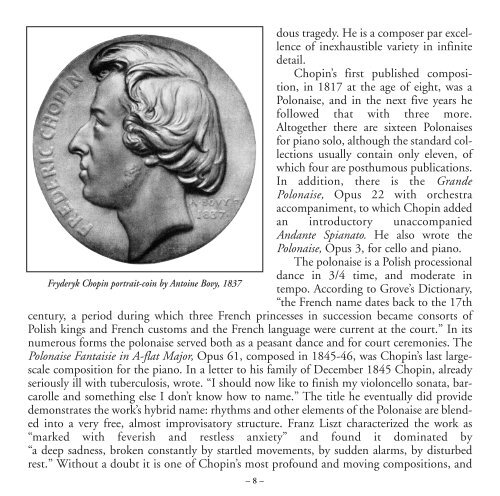70904 for PDF 11/05 - Ivory Classics
70904 for PDF 11/05 - Ivory Classics
70904 for PDF 11/05 - Ivory Classics
You also want an ePaper? Increase the reach of your titles
YUMPU automatically turns print PDFs into web optimized ePapers that Google loves.
Fryderyk Chopin portrait-coin by Antoine Bovy, 1837<br />
dous tragedy. He is a composer par excellence<br />
of inexhaustible variety in infinite<br />
detail.<br />
Chopin’s first published composition,<br />
in 1817 at the age of eight, was a<br />
Polonaise, and in the next five years he<br />
followed that with three more.<br />
Altogether there are sixteen Polonaises<br />
<strong>for</strong> piano solo, although the standard collections<br />
usually contain only eleven, of<br />
which four are posthumous publications.<br />
In addition, there is the Grande<br />
Polonaise, Opus 22 with orchestra<br />
accompaniment, to which Chopin added<br />
an introductory unaccompanied<br />
Andante Spianato. He also wrote the<br />
Polonaise, Opus 3, <strong>for</strong> cello and piano.<br />
The polonaise is a Polish processional<br />
dance in 3/4 time, and moderate in<br />
tempo. According to Grove’s Dictionary,<br />
“the French name dates back to the 17th<br />
century, a period during which three French princesses in succession became consorts of<br />
Polish kings and French customs and the French language were current at the court.” In its<br />
numerous <strong>for</strong>ms the polonaise served both as a peasant dance and <strong>for</strong> court ceremonies. The<br />
Polonaise Fantaisie in A-flat Major, Opus 61, composed in 1845-46, was Chopin’s last largescale<br />
composition <strong>for</strong> the piano. In a letter to his family of December 1845 Chopin, already<br />
seriously ill with tuberculosis, wrote. “I should now like to finish my violoncello sonata, barcarolle<br />
and something else I don’t know how to name.” The title he eventually did provide<br />
demonstrates the work’s hybrid name: rhythms and other elements of the Polonaise are blended<br />
into a very free, almost improvisatory structure. Franz Liszt characterized the work as<br />
“marked with feverish and restless anxiety” and found it dominated by<br />
“a deep sadness, broken constantly by startled movements, by sudden alarms, by disturbed<br />
rest.” Without a doubt it is one of Chopin’s most profound and moving compositions, and<br />
– 8 –














